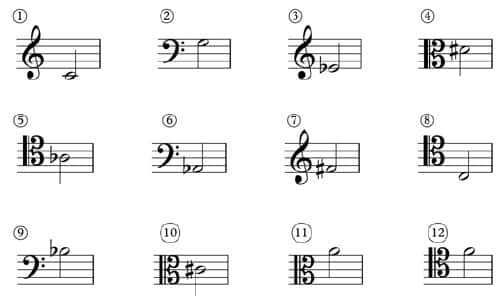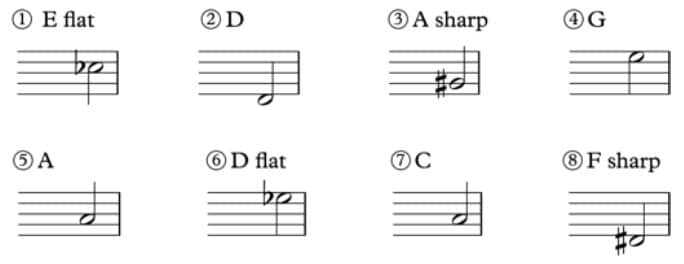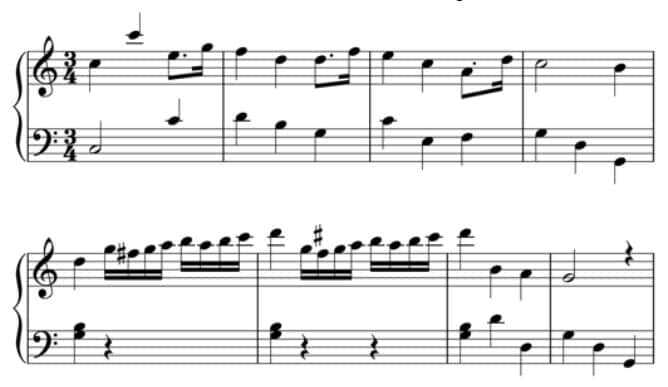Welcome to Day 30!
In these past 29 lessons we’ve been through a lot of material. You now have a solid foundation in musical notation and basic music theory. Well done! The test here covers everything so if you need to revise anything at any time, go ahead. It’s perfectly normal when learning anything new! The summaries at the end of every lesson are specifically designed as a quick reference to the topic of that day.
For this test, all you need are a few sheets of paper, a pencil, and an eraser. As always, the answers are available in our companion course over at
courses.schoolofcomposition.com
1. Why is rhythm one of the most fundamental aspects of music, even more than pitch?
2a. On a separate sheet, name and write the first 5 note values from longest to shortest.
2b. Next to your answers for 2a, write each of those note values’ equivalent rests.
3. In relation to each other, the duration of these note values: (choose only one)
a) is fixed;
b) is always changing;
c) depends on tempo;
d) depends on meter;
4. In order to know exactly how long a note should be played for, we must be aware of: (choose only one)
a) the tempo of the pieces;
b) the meter of the piece;
c) the pulse of the music;
d) both meter and tempo;
5. What does it mean when we say that the meter is in three
or that it is a triple meter? (choose only one)
a) The rhythm repeats three times;
b) The meter is three times faster than before;
c) The strong beat occurs every three beats;
d) The time signature is specifically three-four;
e) The Bpm is a number divisible by three;
6. Meter, represented by the time signature, is essential because: (choose two)
a) It tells us how many beats there are per measure;
b) It tells us how fast the notes should be played;
c) It tells us what type/quality of beats they are;
d) It tells us how many notes there should be per minute;
7. Which one is the correct statement about tempo?
a) Regardless of what the rhythm is, one beat is always played for one second of clock time so that the tempo is not too fast nor too slow.
b) Although the values of the notes in relation to each other are always the same, tempo is important because it determines how fast or slow those notes are.
c) Tempo is not so important because it is the meter that decides the character and mood of the rhythm.
8. Name two ways in which we can add to the duration of a note value.
9. Meters consist of beats. These beats can be: (choose only one)
a) half notes;
b) quarter notes;
c) dotted quarter notes;
d) any note value;
10a. What is the fundamental difference between simple & compound time signatures?
10b. Briefly explain what duplets and triplets are.
11. Name these notes:
12. On a sheet of music paper, write these notes:
a. C
, treble clef, half note;
b. D
sharp, bass clef, whole note;
c. E
flat, alto clef, quarter note;
d. C
sharp, treble clef, quarter note;
e. G
flat, bass clef, half note;
f. A
natural, tenor clef, 16th
note;
g. B
flat, alto clef, whole note;
h. B
natural, tenor clef, 16th
note;
13. Write the proper clef to make these notes correct:
14. On a sheet of music paper, write these notes using 1 or more ledger line/s:
a. C
, bass clef, quarter note;
b. A
sharp, treble clef, half note;
c. B
flat, alto clef, whole note;
d. G
sharp, treble clef, 16th
note;
e. D flat, bass clef, whole note;
f. G natural, tenor clef, quarter note;
g. B flat, treble clef, half note;
h. B natural, tenor clef, 16th
note
15a. Name the given notes. In the empty measure write the note that is a half step above.
15b. On a sheet of music paper, write an enharmonic equivalent of your answers from question 15a.
16. Write the notes that are a whole step below the given notes.
17. How many pitches are there in our musical alphabet? And what are they named?
18. What do we mean when we say that “this F note is an octave higher than this other F note”?
19. What is the difference between a half step and a whole step?
20. What is the function of sharps and flats?
21. What is the name of this accidental and what does it do?
22. Draw a double flat and a double sharp and briefly explain what they do.
23. Write the terms and their symbols for the 2 main dynamic marks of loud
and soft
.
24a. What symbol would you add on the high G notes if you wanted them to be louder (accented) than the surrounding notes?
24b. What symbol would you add to the 3rd
measure if you wanted it to be suddenly softer
?
25. Which articulation mark means very detached and very disconnected?
26. Circle the mistakes in notation of this extract (Hint: there are eight mistakes).
27a. How do you indicate that a piece should be played at exactly 96 quarter note beats per minute?
27b. How would you indicate that a piece should be played at around 80 quarter note beats per minute?
28. What is missing if these were the last 2 measures of a piece?
29. What does da capo al fine
mean?
30. Which symbol instructs the player to engage the piano’s sustain pedal?
End of Test







































